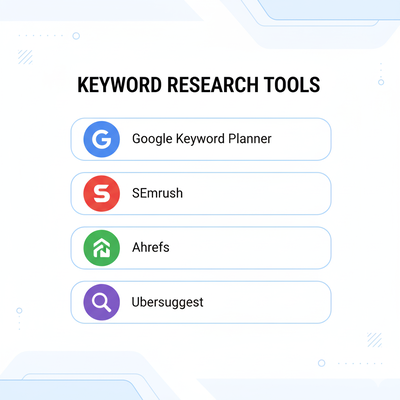Keywords in Content Marketing: The Complete 2025 Guide
Discover what keywords in content marketing are, why they matter, and how to build an effective keyword strategy in 2025. Learn types of keywords, research tools, and tips to boost visibility and attract your target audience.

Introduction
In the fast-moving digital world of 2025, one thing hasn’t changed: keywords are still the backbone of content marketing. Whether it’s a blog, website, or LinkedIn post, keywords help your content reach the right audience.

What are keywords in content marketing? They’re the words and phrases people use in Google, Bing, or AI tools like ChatGPT when searching for answers. For businesses, using keywords the right way means more visibility, better leads, and stronger brand trust.
Why Keywords Still Matter in 2025

Some skeptics argue that AI-driven search is making keywords obsolete. In fact, the importance of keywords in content marketing is greater than ever because they:
- Reveal audience intent → Keywords show exactly what your customers want.
- Guide content strategy → They help decide blog topics, landing page focus, and social campaigns.
- Fuel SEO and GEO → Keywords ensure your brand is seen in Google results and generative AI summaries.
- Support conversions → By targeting transactional and commercial intent keywords, businesses attract ready-to-buy leads.
Without keywords, your content may be great, but it risks staying invisible.
Types of Keywords in Marketing
To create effective campaigns, you need to understand the different types of keywords in marketing and where they fit in the buyer’s journey.
Here’s a breakdown you can use as a reference:
The smartest marketers build strategies that combine all these keyword types—balancing visibility with conversions.
How to Research Keywords in Content Marketing
Here’s a step-by-step keyword research workflow you can follow:
1. Define your goals
Are you aiming for brand awareness, lead generation, or conversions? Your keyword selection will differ based on the outcome you want.
2. Build a seed list
Start with terms you think your audience uses. Pull ideas from sales calls, customer questions, or even social media conversations.
3. Expand with tools
Use tools like Google Keyword Planner, Ahrefs, Semrush, Moz, or AnswerThePublic to uncover related queries, search volumes, and intent.
4. Analyze SERPs
Check your target keywords on the search results page and look at the ‘People Also Ask’ section, featured snippets, and AI summaries. This shows you how Google and generative engines interpret intent.
5. Cluster by intent
Group keywords into categories: information (blogs, guides), transaction (landing pages), and commercial (comparison content).
6. Prioritize
Prioritize by search volume, competition, and business value. Sometimes a lower-volume keyword with high buying intent is more valuable than a high-volume keyword with vague intent.
7. Map to content
Match keywords to specific content types:
Blog posts → informational
Case studies → commercial investigation
Landing pages → transactional
FAQs → AEO (Answer Engine Optimization)
On-Page and Content Best Practices

Once you have your keyword strategy, placement matters. Here’s how to optimize effectively:
Title and H1 tags → Include your primary keyword (e.g., keywords in content marketing).
Meta description → Naturally include secondary keywords for better click-through rates.
Headings (H2/H3) → Use variations like types of keywords in marketing to improve semantic coverage.
First 100 words → Mention the main keyword early so search engines understand context.
Alt text for images → Describe visuals with relevant keywords.
Internal links → Link to related content to strengthen topic clusters.
The Role of Keywords in SEO, AEO, and GEO
Traditional SEO is evolving. Today, businesses must also think about AEO (Answer Engine Optimization) and GEO (Generative Engine Optimization).
SEO → Optimize for ranking in Google and Bing using structured, in-depth content.
AEO → Optimize for voice assistants and answer engines. Structure content in Q&A style with clear, concise answers.
GEO → Optimize for generative search engines like Google SGE, Perplexity, or ChatGPT. Here, authority, credibility, and structured facts matter most.
In every case, the importance of keywords in content marketing remains central. Without them, search engines and AI models won’t know when to surface your content.
How to Measure Keyword Success
Tracking performance ensures your keyword strategy delivers results. Key metrics include:
Organic traffic (via Google Search Console and analytics)
Keyword rankings over time
Click-through rates (CTR) from SERPs
Featured snippet or voice search visibility
AI-generated citation frequency (how often ChatGPT or Perplexity cite your content)
Conversions linked to keyword-driven landing pages
Future of Keywords in Content Marketing
Looking ahead, keywords are shifting from exact-match strings to intent-driven signals. Today’s AI doesn’t just process language, it understands what lies beneath it.
Trends to watch:
Entity-based optimization → Search engines value brands, people, and places as entities, not just words.
Conversation queries → With voice search and AI, natural language keywords (“best coworking spaces near me”) are rising.
AI visibility → Tools are emerging to measure how often your brand appears in generative search outputs.
Content → Short, fact-based answers will become essential for AI and voice snippets.
Conclusion
To wrap up, keywords in content marketing remain the backbone of digital strategy in 2025. They help you match what your audience is looking for, build trust, and stay visible on Google, voice search, and even AI tools.
Knowing what keywords are, the different types, and why they matter in content marketing gives you a clear edge over competitors.
At The Web Pundit, we help businesses craft keyword strategies that go beyond SEO, optimizing for AEO and GEO too. If you’re ready to boost your visibility in both search engines and AI-driven platforms, our team can guide you.

